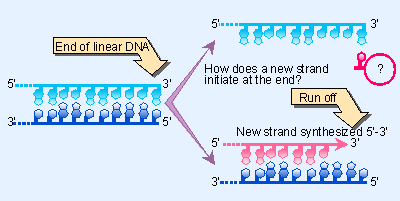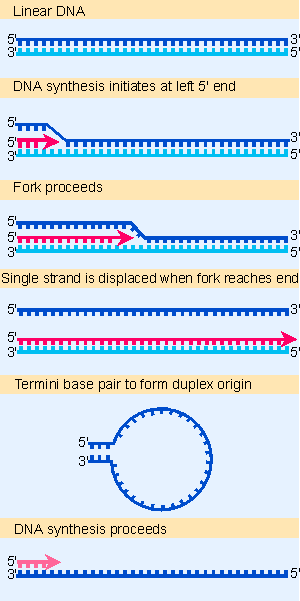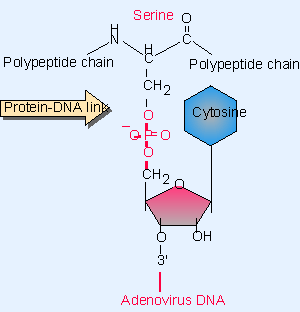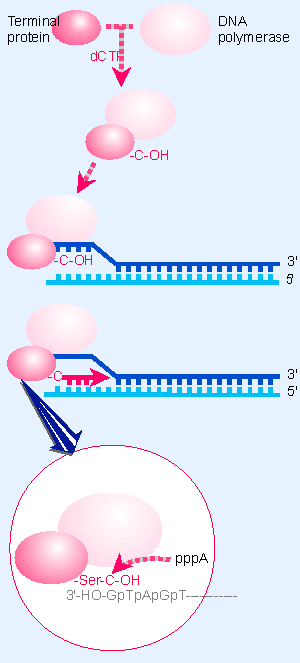7. The problem of linear replicons
12.7 The problem of linear replicons |
| Key terms defined in this section |
| Strand displacement is a mode of replication of some viruses in which a new DNA strand grows by displacing the previous (homologous) strand of the duplex. |
None of the replicons that we have considered so far have a linear end: either they are circular (as in the E. coli or mitochondrial genomes) or they are part of longer segregation units (as in eukaryotic chromosomes). But linear replicons occur, in some cases as single extrachromosomal units, and of course at the ends of eukaryotic chromosomes.
 |
Figure 12.12 Replication could run off the 3 F end of a newly synthesized linear strand, but could it initiate at a 5 F end? |
The ability of all known nucleic acid polymerases, DNA or RNA, to proceed only in the 5′ V 3′ direction poses a problem for synthesizing DNA at the end of a linear replicon. Consider the two parental strands depicted in Figure 12.12. The lower strand presents no problem: it can act as template to synthesize a daughter strand that runs right up to the end, where presumably the polymerase falls off. But to synthesize a complement at the end of the upper strand, synthesis must start right at the very last base (or else this strand would become shorter in successive cycles of replication).
We do not know whether initiation right at the end of a linear DNA is feasible. We usually think of a polymerase as binding at a site surrounding the position at which a base is to be incorporated. So a special mechanism must be employed for replication at the ends of linear replicons. Several types of solution may be imagined to accommodate the need to copy a terminus:
- The problem may be circumvented by converting a linear replicon into a circular or multimeric molecule. Phages such as T4 or lambda use such mechanisms (see later).
- The DNA may form an unusual structure Xfor example, by creating a hairpin at the terminus, so that there is no free end. Formation of a crosslink is involved in replication of the linear mitochondrial DNA of Paramecium.
- Instead of being precisely determined, the end may be variable. Eukaryotic chromosomes may adopt this solution, in which the number of copies of a short repeating unit at the end of the DNA changes (see 18 Chromosomes). A mechanism to add or remove units makes it unnecessary to replicate right up to the very end.
- A protein may intervene to make initiation possible at the actual terminus. Several linear viral nucleic acids have proteins that are covalently linked to the 5′ terminal base. The best characterized examples are adenovirus DNA, phage φ29 DNA, and poliovirus RNA.
 |
Figure 12.13 Adenovirus DNA replication is initiated separately at the two ends of the molecule and proceeds by strand displacement. |
A prime example of initiation at a linear end is provided by adenovirus and φ29 DNAs, which actually replicate from both ends, using the mechanism of strand displacement illustrated in Figure 12.13. The same events can occur independently at either end. Synthesis of a new strand starts at one end, displacing the homologous strand that was previously paired in the duplex. When the replication fork reaches the other end of the molecule, the displaced strand is released as a free single strand. It is then replicated independently; this requires the formation of a duplex origin by base pairing between some short complementary sequences at the ends of the molecule.
 |
Figure 12.14 The 5 F terminal phosphate at each end of adenovirus DNA is covalently linked to serine in the 55 kD Ad-binding protein. |
In several viruses that use such mechanisms, a protein is found covalently attached to each 5′ end. In the case of adenovirus, a terminal protein is linked to the mature viral DNA via a phosphodiester bond to serine, as indicated in Figure 12.14.
 |
Figure 12.15 Adenovirus terminal protein binds to the 5 F end of DNA and provides a C-OH end to prime synthesis of a new DNA strand. |
How does the attachment of the protein overcome the initiation problem? The terminal protein has a dual role: it carries a cytidine nucleotide that provides the primer; and it is associated with DNA polymerase. In fact, linkage of terminal protein to a nucleotide is undertaken by DNA polymerase in the presence of adenovirus DNA. This suggests the model illustrated in Figure 12.15. The complex of polymerase and terminal protein, bearing the priming C nucleotide, binds to the end of the adenovirus DNA. The free 3′ VOH end of the C nucleotide is used to prime the elongation reaction by the DNA polymerase. This generates a new strand whose 5′ end is covalently linked to the initiating C nucleotide. (The reaction actually involves displacement of protein from DNA rather than binding de novo. The 5′ end of adenovirus DNA is bound to the terminal protein that was used in the previous replication cycle. The old terminal protein is displaced by the new terminal protein for each new replication cycle.)
Terminal protein binds to the region located between 9 and 18 bp from the end of the DNA. The adjacent region, between positions 17 and 48, is essential for the binding of a host protein, nuclear factor I, which is also required for the initiation reaction. The initiation complex may therefore form between positions 9 and 48, a fixed distance from the actual end of the DNA.